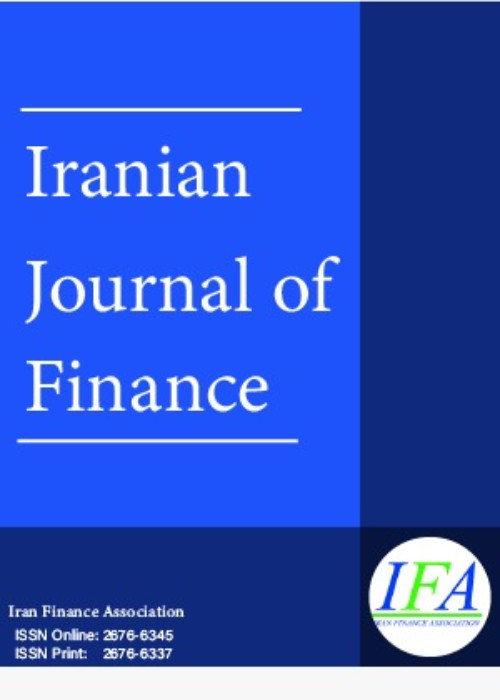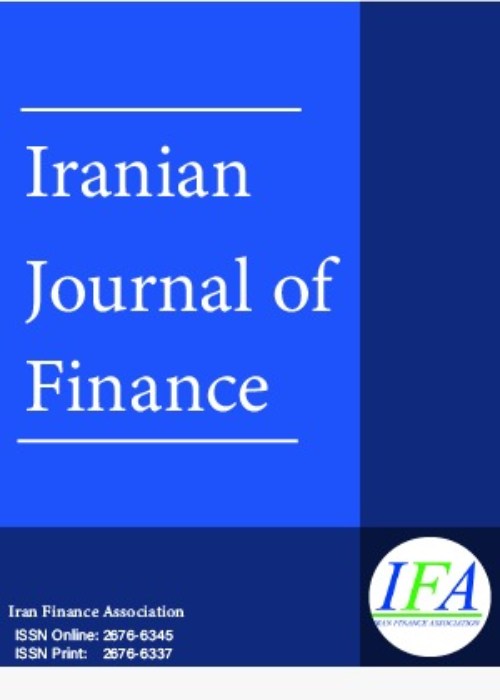فهرست مطالب

Iranian Journal of Finance
Volume:7 Issue: 3, Summer 2023
- تاریخ انتشار: 1402/07/01
- تعداد عناوین: 6
-
-
Pages 1-24
Volatility and risk measurement are essential parameters in risk management programs that can affect economic activities and public confidence in the stock market. Also, these two are the keys in the studies that connect the stock market, economic growth, and other financial factors. In recent years, due to the instability in the Tehran Stock Exchange, controlling the adverse effects caused by the volatility of stock prices, predicting and modeling price dynamics, and measuring risk have become necessary for the participants in this market. In the present research, the class of hidden Markovian index models of conditional variance Heteroskedasticity (HM-GARCH) is used to predict the volatility of stock prices and accounts of the Tehran Stock Exchange. For a comprehensive review, the models are selected to include the characteristics of volatility clustering, asymmetry in volatility (leverage effect), and heavy tail of stock returns (with t-student distribution). Based on RMSE and AME criteria, the HM-EGARCH-Normal Exponential GARCH model with normal distribution is more effective than other models in predicting stock market volatility. Therefore, leverage is necessary to analyze stock market risks using hidden Markov models, but heavy tail distribution is unnecessary. The results indicate that the HM-EGARCH-Normal model appropriately assesses volatility and improves market transparency and risk management forecasts. Also, the VaR and CVaR market risk assessment post-tests using Kupiec and DQ tests do not show evidence of overestimation or underestimation.
Keywords: Stock Market, VaR, Hidden Markov Models, Risk, Kupiec Test, DQ Test -
Pages 25-47
Corporate Social Responsibility (CSR) concept is closely related to the notion of sustainable development, and the outcome of the sustainable development approach is specific consideration to disclosure and reporting of CSR. One factor that is less considered in the Iranian economic environment and research is the competitive nature of the product market in today's highly competitive and sensitive environment. So, the main aim of this paper is to investigate the moderating effect of competition in the product market on the debts ratio and the CSR relation among companies listed on the Tehran Stock Exchange. The independent variable in this study is CSR, and the dependent variable is the debts ratio. In order to investigate this issue, the research sample was determined using the systematic elimination method, and 97 companies were selected for seven years from 2012 to 2018. Multivariate regression was used to analyze the data and test the hypothesis. For this purpose, the output-oriented BCC model has been used to measure companies' CSR, and the Lerner index has been used to represent competition in the product market. The results show that high competition in the product market moderates the relationship between CSR and debts ratio. In other words, when competition in the product market is high, Firms adopt lower debt ratios by fulfilling their social responsibilities. The investigation of the moderating effect of the competition is the distinguishing feature of our research compared to other studies. Therefore, players of industry, business, creditors, and investors should pay attention to the intensity of competition in the market.
Keywords: Corporate Social Responsibility, Lerner Index, Competition in The Product Market, Debts Ratio -
Pages 48-72
High transaction costs have been cited as limiting access to credit in developing countries. This issue is much more critical for knowledge-based companies due to their position in accelerating economic growth and the particular characteristics of these companies. Therefore, this research aims to evaluate the transaction cost of financing knowledge-based companies from an official fund in Iran that provides financial support for innovations and technologies. The data was collected through interviews and questionnaires in a sampling of knowledge-based companies in 2022. In this study, after calculating the transaction costs of financing, the effect of the factors affecting it has been investigated. The investigated sample was 123 companies from the fund's customers. The results showed that, on average, the ratio of transaction cost to the facility, transaction cost rate, total cost rate (transaction cost and interest rate), and the ratio of transaction cost to interest rate are equal to 3.33, 7.04, 15.66, and 0.81, respectively. Based on the results, the facility amount, the number of payment steps, the distance between the request for the facility and the contract, the interest rate, and dummy variables for the type of facility have a positive and significant effect on the transaction cost.
Keywords: Transaction Cost, Financing, Knowledge-Based Companies, Iran -
Pages 73-94
This study aimed to develop an internal control model for the Iranian Social Security Organization with a risk management approach. This exploratory study is applied in terms of objective, and the statistical population comprised 340 employees in the financial department of the Iranian Social Security Organization. The data was collected using interviews and questionnaires, and the hypotheses were tested with inferential statistics and structural equation tests. The results showed that the internal control factors of the Iranian Social Security Organization include the income bank system, the legal obligations system, compensation, the financial bookkeeping system, the movable and immovable property system, the financial management system, and check issuance requirements. The results also showed that the factors affecting internal controls are among the factors influencing risk management. Considering the extent of branches, dimensions, various services including (retirement, disability) and the size and volume of financial operations, as well as the very high budget of the Social Security Organization (for example, in 1401, the budget of the Social Security Organization is 500 thousand billion Rials), there are many factors on the controls Empty and effective risk management. The most important factors affecting the Social Security Organization's internal controls' efficacy are the financial bookkeeping system, Payroll system, And Legal requirements for issuing checks.
Keywords: Internal controls, Risk Management, Risk, Iranian Social Security Organization -
Pages 95-119
As a trading strategy, pairs trading is performed based on the arbitrage opportunities extracted from statistical models. It is an outcome of the distance between an asset pair and the equilibrium state. Consequently, selecting a pair with the potential to form long-term relationships and reverting to the mean is the main challenge associated with pair trading. Cointegration is one of the most famous statistical tests for selecting a pair's trading. The present study uses Empirical Mode Decomposition (EMD) to decompose the time series of an asset pair price into its constituent elements (intrinsic mode functions). This study examined the property of cointegration across different levels and the corresponding levels of 2- time series to find the cointegration pairs in different decomposition levels and finally examine the resulting profitability. To this end, the profitability of the pairs trading system related to 14 stocks of the Tehran Stock Exchange throughout 2012-2021 was investigated based on EMD. The results showed that the outputs are pretty noticeable for the first level of decomposition (the first intrinsic mode function), and the number of trading opportunities increased by more than two times compared to the normal pair trading with cointegration; the daily returns increased by four times; and the Sharpe ratio increased by about two times compared to the normal pairs trading. The system formed based on the second mode function also outperformed the normal cointegration, and the performance of the third intrinsic mode function is almost on par with that of cointegration. Moreover, the mean transaction duration decreased remarkably in the first and second mode functions.
Keywords: Statistical Arbitrage, Pairs Trading, Empirical Mode Decomposition, Sharpe Ratio -
Pages 120-139
Holding companies collect funds from subsidiaries and allocate them to important areas (Internal Capital Market). Managers of holding companies have the ability to transfer funds between subsidiaries. Some specific orientations cause the non-optimal allocation of financial resources. One of the concerns of investors is investing in companies where transparency is fully implemented. Companies are trying to achieve this by implementing corporate governance mechanisms. In this research, using a systematic review method, the dimensions of corporate governance were extracted with the stakeholder theory approach. Finally, in order to examine the question of whether the managers of holding companies consider the interests of all stakeholders when using the internal capital market or not, according to the assumptions of the research, the dimensions of corporate governance on stakeholders have been investigated. To investigate this relationship, a set of questions based on Likert scale about the measured variables of the target society was designed. After data collection, finally, data analysis was done by statistical method using SPSS software and structural equations using SPLS software, and the results of path analysis and causal relationships between the research variables were interpreted in the conceptual model. The data analysis also showed that the value of the path coefficient, the effects of dimensions and components of corporate governance and stakeholders, is a positive value. The null hypothesis of the research is rejected and the opposite hypothesis is confirmed. This shows that there is a relationship between the effects of corporate governance dimensions and stakeholders. The direct effect value indicates a strong and high effect size. As a result, the interests of all stakeholders should be considered.
Keywords: Internal Capital Market, Stakeholder Theory, Holding Companies, Corporate Governance, Social Corporate Responsibility


